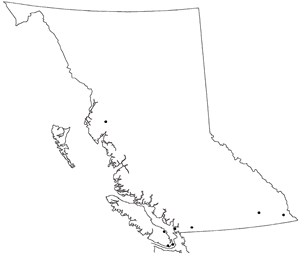This is an introduced European species of earthworm. Reynolds (1977) provides the following description for it: “Length 90-300 mm, diameter 6-10 mm, segment number 120-160, prostomium tanylobic, first dorsal pore 7/8. Clitellum xxxi, xxxii-xxxvii. Tubercula pubertatis xxxiii-xxxvi. Setae enlarged and widely paired in the caudal and cephalic regions (i.e. AB and CD are greater) but closely paired and smaller in the central region, AA>BC,AB>CD, and DD = ½C anteriorly, DD<½C posteriorly. The ventral setae of x, xxvi, and sometimes xxv are on broad genital tumescences modified into genital setae. Genital tumescences, occasionally in viii-xiv and xxiv-xxxix. Males pores prominent with large elevated glandular papillae extending over xiv-xvi. Seminal vesicles, three pairs in 9, 11, and 12+13. Spermathecae, two pairs with short ducts opening at 9/10 and 10/11. Body cylindrical and strongly compressed dorsoventrally posteriorly. Heavily pigmented, brownish-red, or violet colour on dorsum and yellowish-orange on venter.”
Source: Reynolds, John W. 1977. The Earthworms (Lumbricidae and Sparganophilidae) of Ontario. Life Science Miscellaneous Publications, Royal Ontario Musuem, Toronto, with permission.
Lumbricus terrestris Linnaeus, 1758
Dew-Worm; Earthworm; Nightcrawler
Family: Lumbricidae
Dew-Worm; Earthworm; Nightcrawler
Family: Lumbricidae
Map

Distribution of Lumbricus terrestris in British Columbia.
(Click on the map to view a larger version.)
Source: Marshall and Fender (2007)
Introduction
|
Illustration
Click on the image(s) below to view an expanded illustration for this taxon.

Illustration Source: Reynolds, John W. 1977. The Earthworms (Lumbricidae and Sparganophilidae) of Ontario. Life Science Miscellaneous Publications, Royal Ontario Museum, Toronto.
Species Information
Biology
|
Habitat
|
Distribution
|
Status Information
BC Ministry of Environment: BC Species and Ecosystems Explorer--the authoritative source for conservation information in British Columbia. |